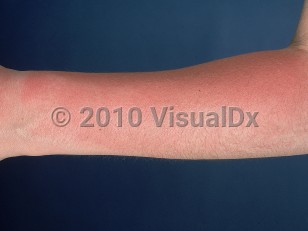Sunburn in Child
Alerts and Notices
Important News & Links
Synopsis

Sunburn (solar erythema) is the skin's reaction to excessive ultraviolet (UV) light exposure. It presents as reddening and tenderness of the skin that typically appears 30 minutes to 8 hours after exposure and peaks between 12 and 24 hours after exposure. UVB radiation is much more potent than UVA at inducing erythema; the 300-nm wavelength within the UVB range is the most erythemogenic. Severe sunburn can evolve into edema, blistering, and desquamation, the latter of which occurs 4-7 days after the exposure as the erythema is fading. Extreme reactions may include systemic symptoms such as chills and malaise and may necessitate hospitalization and management similar to thermal burns. Sunburn incidence is increased in areas that are closer to the equator and higher in altitude. Sunburn occurs more frequently in lighter-skinned individuals and in younger age groups. Darker skin colors are more resistant to sunburn due to increased epidermal melanin content, type of melanin produced (ie, eumelanin versus pheomelanin), and different melanosome dispersion patterns. Skin phototypes (Fitzpatrick classification) are classified on the basis of susceptibility to sunburn and ability to tan:
Skin phototype:
I: Always burns, never tans
II: Frequently burns, rarely tans
III: Infrequently burns, usually tans
IV: Low susceptibility to sunburn, light brown skin color
V: Very low susceptibility to sunburn, brown skin color
VI: Extremely low susceptibility to sunburn, dark brown skin color
Although sunburn is self-limiting, there is morbidity and mortality associated with long-term sun exposure. UV radiation (UVR) causes direct DNA damage to the skin cells in addition to suppression of skin immunity. Repeated exposure can cause permanent DNA damage. Sunburn is a risk factor for the development of squamous cell carcinoma, basal cell carcinoma, and melanoma. Having as little as 5 sunburns over a decade or 1 sunburn every 10 years can result in up to triple the risk of melanoma. Both childhood and adult sunburns can contribute to melanoma risk.
Skin phototype:
I: Always burns, never tans
II: Frequently burns, rarely tans
III: Infrequently burns, usually tans
IV: Low susceptibility to sunburn, light brown skin color
V: Very low susceptibility to sunburn, brown skin color
VI: Extremely low susceptibility to sunburn, dark brown skin color
Although sunburn is self-limiting, there is morbidity and mortality associated with long-term sun exposure. UV radiation (UVR) causes direct DNA damage to the skin cells in addition to suppression of skin immunity. Repeated exposure can cause permanent DNA damage. Sunburn is a risk factor for the development of squamous cell carcinoma, basal cell carcinoma, and melanoma. Having as little as 5 sunburns over a decade or 1 sunburn every 10 years can result in up to triple the risk of melanoma. Both childhood and adult sunburns can contribute to melanoma risk.
Codes
ICD10CM:
L55.9 – Sunburn, unspecified
SNOMEDCT:
403194002 – Solar erythema
L55.9 – Sunburn, unspecified
SNOMEDCT:
403194002 – Solar erythema
Look For
Subscription Required
Diagnostic Pearls
Subscription Required
Differential Diagnosis & Pitfalls

To perform a comparison, select diagnoses from the classic differential
Subscription Required
Best Tests
Subscription Required
Management Pearls
Subscription Required
Therapy
Subscription Required
References
Subscription Required
Last Reviewed:06/11/2022
Last Updated:07/11/2022
Last Updated:07/11/2022
 Patient Information for Sunburn in Child
Patient Information for Sunburn in Child
Premium Feature
VisualDx Patient Handouts
Available in the Elite package
- Improve treatment compliance
- Reduce after-hours questions
- Increase patient engagement and satisfaction
- Written in clear, easy-to-understand language. No confusing jargon.
- Available in English and Spanish
- Print out or email directly to your patient
Upgrade Today

Sunburn in Child

